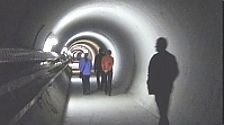
The use of cement and concrete as fracture grouting or as tunnel seals in a geological disposal facility for radioactive wastes creates potential issues concerning chemical reactivity. The elevated pH (>11) of pore fluids in such materials can lead to the instability of minerals in the host rock formation, increased solubility, and changes in the physical properties of the engineered barrier, such as porosity or permeability.
The Long-term Cement Studies (LCS) project is an international collaboration between JAEA (Japan), Nagra (Switzerland), RWM (UK), Posiva (Finland) and SKB (Sweden) aimed at increasing the understanding of these high-pH cement interaction effects in the repository near-field and the geosphere. By doing so, we can develop confidence in the predictions of likely future system behaviour. An emphasis is placed within the LCS project on in-situ field experiments, conducted at the Grimsel Test Laboratory in the Swiss Alps, with more realistic boundary conditions and longer time scales. This is supported by modelling work.
In the first stage of this project, Quintessa supported RWM by modelling cement hydration reactions and the advective flow of hyperalkaline fluid through a column of fractured rock. In the second stage of the project, we turned our attention to the modelling of analogue sites, which can provide invaluable insights into the long-term behaviour of cement-rock systems. The first of these was the industrial analogue at Tournemire, France, where cement-filled boreholes have been in contact with the mudstone host rock for 15 to 20 years. Here the model was able to predict the alteration of minerals both in the cement and the mudstone around the edge of the borehole, agreeing well with laboratory results. Following this, the natural analogue site at Maqarin, Jordan was modelled. Here a natural high-pH fluid flows along fractures through marl, resulting in a complex sequence of fracture mineralisation and sealing and subsequent reactivation. An important consideration here is the formation of minerals on fracture walls and the possible "armouring" of the fracture, something that we are beginning to capture in our models.